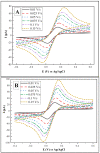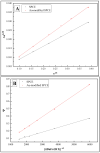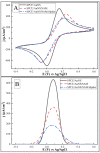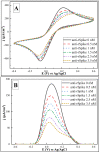Determination of rSpike Protein by Specific Antibodies with Screen-Printed Carbon Electrode Modified by Electrodeposited Gold Nanostructures
- PMID: 36004989
- PMCID: PMC9405582
- DOI: 10.3390/bios12080593
Determination of rSpike Protein by Specific Antibodies with Screen-Printed Carbon Electrode Modified by Electrodeposited Gold Nanostructures
Abstract
In this research, we assessed the applicability of electrochemical sensing techniques for detecting specific antibodies against severe acute respiratory syndrome coronavirus 2 (SARS-CoV-2) spike proteins in the blood serum of patient samples following coronavirus disease 2019 (COVID-19). Herein, screen-printed carbon electrodes (SPCE) with electrodeposited gold nanostructures (AuNS) were modified with L-Cysteine for further covalent immobilization of recombinant SARS-CoV-2 spike proteins (rSpike). The affinity interactions of the rSpike protein with specific antibodies against this protein (anti-rSpike) were assessed using cyclic voltammetry (CV) and differential pulse voltammetry (DPV) methods. It was revealed that the SPCE electroactive surface area increased from 1.49 ± 0.02 cm2 to 1.82 ± 0.01 cm2 when AuNS were electrodeposited, and the value of the heterogeneous electron transfer rate constant (k0) changed from 6.30 × 10-5 to 14.56 × 10-5. The performance of the developed electrochemical immunosensor was evaluated by calculating the limit of detection and limit of quantification, giving values of 0.27 nM and 0.81 nM for CV and 0.14 nM and 0.42 nM for DPV. Furthermore, a specificity test was performed with a solution of antibodies against bovine serum albumin as the control aliquot, which was used to assess nonspecific binding, and this evaluation revealed that the developed rSpike-based sensor exhibits low nonspecific binding towards anti-rSpike antibodies.
Keywords: COVID-19; SARS-CoV-2 virus; antigen–antibody complex; cyclic voltammetry (CV); differential pulse voltammetry (DPV); electrochemical immunosensor; electrochemical impedance spectroscopy (EIS); gold nanostructures (AuNS); self-assembled monolayer (SAM); spike protein (Spike).
Conflict of interest statement
The authors declare no conflict of interest.
Figures











Similar articles
-
Electrochemical Determination of Interaction between SARS-CoV-2 Spike Protein and Specific Antibodies.Int J Mol Sci. 2022 Jun 17;23(12):6768. doi: 10.3390/ijms23126768. Int J Mol Sci. 2022. PMID: 35743208 Free PMC article.
-
Electrochemical biosensing based comparative study of monoclonal antibodies against SARS-CoV-2 nucleocapsid protein.Sci Total Environ. 2024 Jan 15;908:168154. doi: 10.1016/j.scitotenv.2023.168154. Epub 2023 Nov 1. Sci Total Environ. 2024. PMID: 37923263
-
Electrochemical immunosensors using electrodeposited gold nanostructures for detecting the S proteins from SARS-CoV and SARS-CoV-2.Anal Bioanal Chem. 2022 Jul;414(18):5507-5517. doi: 10.1007/s00216-022-03956-1. Epub 2022 Feb 15. Anal Bioanal Chem. 2022. PMID: 35169906 Free PMC article.
-
Ultrasensitive electrochemical immunosensor system for determination of autologous SOX2 antibody.J Pharm Biomed Anal. 2024 Apr 15;241:115992. doi: 10.1016/j.jpba.2024.115992. Epub 2024 Jan 20. J Pharm Biomed Anal. 2024. PMID: 38277708 Review.
-
ZnO nanostructures: A promising frontier in immunosensor development.Biosens Bioelectron. 2024 Feb 15;246:115848. doi: 10.1016/j.bios.2023.115848. Epub 2023 Nov 19. Biosens Bioelectron. 2024. PMID: 38042053 Review.
Cited by
-
MoS2/MWCNT Nanostructure: Enhanced Performance of Screen-Printed Carbon Electrode for Voltammetric Determination of 4-Nitrophenol in Water Samples.Micromachines (Basel). 2025 Mar 23;16(4):366. doi: 10.3390/mi16040366. Micromachines (Basel). 2025. PMID: 40283243 Free PMC article.
-
Systematically investigating the fluorescent signal readout of CRISPR-Cas12a for highly sensitive SARS-CoV-2 detection.Sens Actuators B Chem. 2022 Dec 15;373:132746. doi: 10.1016/j.snb.2022.132746. Epub 2022 Sep 30. Sens Actuators B Chem. 2022. PMID: 36212739 Free PMC article.
-
Polyaniline-based electrochemical immunosensor for the determination of antibodies against SARS-CoV-2 spike protein.Sci Total Environ. 2023 Mar 1;862:160700. doi: 10.1016/j.scitotenv.2022.160700. Epub 2022 Dec 7. Sci Total Environ. 2023. PMID: 36493838 Free PMC article.
-
Electrochemical Immunosensor for the Determination of Antibodies against Prostate-Specific Antigen Based on ZnO Nanostructures.Int J Mol Sci. 2023 Mar 18;24(6):5803. doi: 10.3390/ijms24065803. Int J Mol Sci. 2023. PMID: 36982877 Free PMC article.
-
Electrochemical Biosensor for the Determination of Specific Antibodies against SARS-CoV-2 Spike Protein.Int J Mol Sci. 2022 Dec 31;24(1):718. doi: 10.3390/ijms24010718. Int J Mol Sci. 2022. PMID: 36614164 Free PMC article.
References
-
- Yadav A., Verma D., Kumar A., Kumar P., Solanki P. The perspectives of biomarker-based electrochemical immunosensors, artificial intelligence and the Internet of Medical Things toward COVID-19 diagnosis and management. Mater. Today Chem. 2021;20:100443. doi: 10.1016/j.mtchem.2021.100443. - DOI - PMC - PubMed
MeSH terms
Substances
Grants and funding
LinkOut - more resources
Full Text Sources
Medical
Miscellaneous

